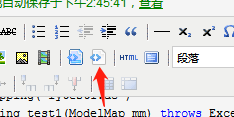先导文:写完上一篇文章,被我家吾皇训斥了许久。为了表达的我歉意,特意附上一篇工具包。
以下是工具包代码:
package web; import java.io.InputStream; import java.io.OutputStream; import java.lang.reflect.Field; import java.text.SimpleDateFormat; import java.util.ArrayList; import java.util.Arrays; import java.util.Date; import java.util.Iterator; import java.util.LinkedHashMap; import java.util.List; import java.util.Map; import java.util.Map.Entry; import org.apache.poi.hssf.usermodel.HSSFCell; import org.apache.poi.hssf.usermodel.HSSFRow; import org.apache.poi.hssf.usermodel.HSSFSheet; import org.apache.poi.hssf.usermodel.HSSFWorkbook; public class ExeclUtil { static int sheetsize = 5000; /** * @author Lyy * @param data * 导入到excel中的数据 * @param out * 数据写入的文件 * @param fields * 需要注意的是这个方法中的map中:每一列对应的实体类的英文名为键,excel表格中每一列名为值 * @throws Exception */ public static <T> void ListtoExecl(List<T> data, OutputStream out, Map<String, String> fields) throws Exception { HSSFWorkbook workbook = new HSSFWorkbook(); // 如果导入数据为空,则抛出异常。 if (data == null || data.size() == 0) { workbook.close(); throw new Exception("导入的数据为空"); } // 根据data计算有多少页sheet int pages = data.size() / sheetsize; if (data.size() % sheetsize > 0) { pages += 1; } // 提取表格的字段名(英文字段名是为了对照中文字段名的) String[] egtitles = new String[fields.size()]; String[] cntitles = new String[fields.size()]; Iterator<String> it = fields.keySet().iterator(); int count = 0; while (it.hasNext()) { String egtitle = (String) it.next(); String cntitle = fields.get(egtitle); egtitles[count] = egtitle; cntitles[count] = cntitle; count++; } // 添加数据 for (int i = 0; i < pages; i++) { int rownum = 0; // 计算每页的起始数据和结束数据 int startIndex = i * sheetsize; int endIndex = (i + 1) * sheetsize - 1 > data.size() ? data.size() : (i + 1) * sheetsize - 1; // 创建每页,并创建第一行 HSSFSheet sheet = workbook.createSheet(); HSSFRow row = sheet.createRow(rownum); // 在每页sheet的第一行中,添加字段名 for (int f = 0; f < cntitles.length; f++) { HSSFCell cell = row.createCell(f); cell.setCellValue(cntitles[f]); } rownum++; // 将数据添加进表格 for (int j = startIndex; j < endIndex; j++) { row = sheet.createRow(rownum); T item = data.get(j); for (int h = 0; h < cntitles.length; h++) { Field fd = item.getClass().getDeclaredField(egtitles[h]); fd.setAccessible(true); Object o = fd.get(item); String value = o == null ? "" : o.toString(); HSSFCell cell = row.createCell(h); cell.setCellValue(value); } rownum++; } } // 将创建好的数据写入输出流 workbook.write(out); // 关闭workbook workbook.close(); } /**
* @author Lyy
* @param entityClass excel中每一行数据的实体类
* @param in excel文件
* @param fields 字段名字
* 需要注意的是这个方法中的map中:
* excel表格中每一列名为键,每一列对应的实体类的英文名为值
* @throws Exception
*/ public static <T> List<T> ExecltoList(InputStream in, Class<T> entityClass, Map<String, String> fields) throws Exception { List<T> resultList = new ArrayList<T>(); HSSFWorkbook workbook = new HSSFWorkbook(in); // excel中字段的中英文名字数组 String[] egtitles = new String[fields.size()]; String[] cntitles = new String[fields.size()]; Iterator<String> it = fields.keySet().iterator(); int count = 0; while (it.hasNext()) { String cntitle = (String) it.next(); String egtitle = fields.get(cntitle); egtitles[count] = egtitle; cntitles[count] = cntitle; count++; } // 得到excel中sheet总数 int sheetcount = workbook.getNumberOfSheets(); if (sheetcount == 0) { workbook.close(); throw new Exception("Excel文件中没有任何数据"); } // 数据的导出 for (int i = 0; i < sheetcount; i++) { HSSFSheet sheet = workbook.getSheetAt(i); if (sheet == null) { continue; } // 每页中的第一行为标题行,对标题行的特殊处理 HSSFRow firstRow = sheet.getRow(0); int celllength = firstRow.getLastCellNum(); String[] excelFieldNames = new String[celllength]; LinkedHashMap<String, Integer> colMap = new LinkedHashMap<String, Integer>(); // 获取Excel中的列名 for (int f = 0; f < celllength; f++) { HSSFCell cell = firstRow.getCell(f); excelFieldNames[f] = cell.getStringCellValue().trim(); // 将列名和列号放入Map中,这样通过列名就可以拿到列号 for (int g = 0; g < excelFieldNames.length; g++) { colMap.put(excelFieldNames[g], g); } } // 由于数组是根据长度创建的,所以值是空值,这里对列名map做了去空键的处理 colMap.remove(null); // 判断需要的字段在Excel中是否都存在 // 需要注意的是这个方法中的map中:中文名为键,英文名为值 boolean isExist = true; List<String> excelFieldList = Arrays.asList(excelFieldNames); for (String cnName : fields.keySet()) { if (!excelFieldList.contains(cnName)) { isExist = false; break; } } // 如果有列名不存在,则抛出异常,提示错误 if (!isExist) { workbook.close(); throw new Exception("Excel中缺少必要的字段,或字段名称有误"); } // 将sheet转换为list for (int j = 1; j <= sheet.getLastRowNum(); j++) { HSSFRow row = sheet.getRow(j); // 根据泛型创建实体类 T entity = entityClass.newInstance(); // 给对象中的字段赋值 for (Entry<String, String> entry : fields.entrySet()) { // 获取中文字段名 String cnNormalName = entry.getKey(); // 获取英文字段名 String enNormalName = entry.getValue(); // 根据中文字段名获取列号 int col = colMap.get(cnNormalName); // 获取当前单元格中的内容 String content = row.getCell(col).toString().trim(); // 给对象赋值 setFieldValueByName(enNormalName, content, entity); } resultList.add(entity); } } workbook.close(); return resultList; } /** * @MethodName : setFieldValueByName * @Description : 根据字段名给对象的字段赋值 * @param fieldName * 字段名 * @param fieldValue * 字段值 * @param o * 对象 */ private static void setFieldValueByName(String fieldName, Object fieldValue, Object o) throws Exception { Field field = getFieldByName(fieldName, o.getClass()); if (field != null) { field.setAccessible(true); // 获取字段类型 Class<?> fieldType = field.getType(); // 根据字段类型给字段赋值 if (String.class == fieldType) { field.set(o, String.valueOf(fieldValue)); } else if ((Integer.TYPE == fieldType) || (Integer.class == fieldType)) { field.set(o, Integer.parseInt(fieldValue.toString())); } else if ((Long.TYPE == fieldType) || (Long.class == fieldType)) { field.set(o, Long.valueOf(fieldValue.toString())); } else if ((Float.TYPE == fieldType) || (Float.class == fieldType)) { field.set(o, Float.valueOf(fieldValue.toString())); } else if ((Short.TYPE == fieldType) || (Short.class == fieldType)) { field.set(o, Short.valueOf(fieldValue.toString())); } else if ((Double.TYPE == fieldType) || (Double.class == fieldType)) { field.set(o, Double.valueOf(fieldValue.toString())); } else if (Character.TYPE == fieldType) { if ((fieldValue != null) && (fieldValue.toString().length() > 0)) { field.set(o, Character.valueOf(fieldValue.toString().charAt(0))); } } else if (Date.class == fieldType) { field.set(o, new SimpleDateFormat("yyyy-MM-dd HH:mm:ss") .parse(fieldValue.toString())); } else { field.set(o, fieldValue); } } else { throw new Exception(o.getClass().getSimpleName() + "类不存在字段名 " + fieldName); } } /** * @MethodName : getFieldByName * @Description : 根据字段名获取字段 * @param fieldName * 字段名 * @param clazz * 包含该字段的类 * @return 字段 */ private static Field getFieldByName(String fieldName, Class<?> clazz) { // 拿到本类的所有字段 Field[] selfFields = clazz.getDeclaredFields(); // 如果本类中存在该字段,则返回 for (Field field : selfFields) { if (field.getName().equals(fieldName)) { return field; } } // 否则,查看父类中是否存在此字段,如果有则返回 Class<?> superClazz = clazz.getSuperclass(); if (superClazz != null && superClazz != Object.class) { return getFieldByName(fieldName, superClazz); } // 如果本类和父类都没有,则返回空 return null; } }
以下是该工具包的使用:
1 public class TestController { 2 3 @RequestMapping("lytest.do") 4 public String test(HttpServletRequest req, Student stu1) throws Exception { 5 List<Student> li = new ArrayList<Student>(); 6 li.add(stu1); 7 OutputStream out = new FileOutputStream("d://aa.xls"); 8 Map<String, String> fields = new HashMap<String, String>(); 9 fields.put("uid", "学号"); 10 fields.put("uname", "姓名"); 11 fields.put("sex", "性别"); 12 fields.put("nation", "民族"); 13 ExeclUtil.ListtoExecl(li, out, fields); 14 out.close(); 15 return "index"; 16 } 17 18 @RequestMapping("lytest1.do") 19 public String test1(ModelMap mm) throws Exception { 20 InputStream in = new FileInputStream("d://aa.xls"); 21 Map<String, String> fieldd = new HashMap<String, String>(); 22 fieldd.put("学号", "uid"); 23 fieldd.put("姓名", "uname"); 24 fieldd.put("性别", "sex"); 25 fieldd.put("民族", "nation"); 26 List<Student> resultList = new ArrayList<Student>(); 27 resultList = ExeclUtil.ExecltoList(in, Student.class, fieldd); 28 mm.put("lists", resultList); 29 return "index"; 30 } 31 32 }
-------------------------------------------------------------------我是分隔符--------------------------------------------------------------------------------------
我家吾皇,我知道 你不知道怎么插入代码。
特此附图一张
-------------------------------------------------------------------我是分隔符--------------------------------------------------------------------------------------
请不要说我家吾皇傻,平时不开口,看不出来的。